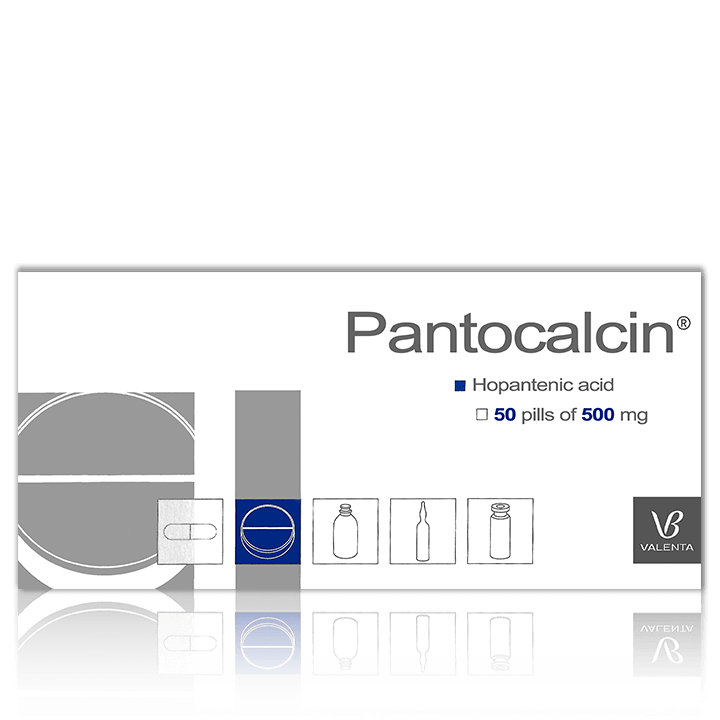Pantocalcin® (Hopantenic acid) Instruction
International Non-Proprietary Name (INN): hopantenic acid
Dosage form: pills (500 or 250 mg)
Structure
1 pill contains:
Active ingredient: calcium hopantenate (hopantenic acid or calcium salt of hopantenic acid) 500 or 250 mg;
Excipients: magnesium hydroxycarbonate – 46.77 or 93.54 mg, calcium stearate – 3.1 or 6.2 mg, talc – 6.2 or 12.4 mg, solani amylum – 3.93 or 7.86 mg.
Description
White color of a flat-cylindrical form with a facet and a breaking line.
Pharmacological classification: nootropic
ATC code: N06BX
Pharmacological action: nootropic

Pharmacodynamics
The spectrum of action is attributed to the presence of GABA in the drug structure. The mechanism of action is determined by the direct effect of the Pantocalcin® drug on the GABAB receptor-channel complex. It has neurometabolic, neuroprotective, and neurotrophic properties. It increases brain resistance to hypoxia and to effects of toxic substances and stimulates anabolic processes in neurons. It has the anticonvulsant effect; reduces motor excitability while regulating behavior. The drug increases mental activity and performance capability. It helps normalize the level of GABA in case of chronic alcohol intoxication and the subsequent abolition of ethanol. It has an analgesic effect. It can inhibit acetylation reactions participating in mechanisms of Novocain and sulfonamides inactivation, due to which the prolongation of the action of the latter is achieved. It causes inhibition of the pathologically increased vesical reflex and the detrusor tonus.
Pharmacokinetics
When taken orally, it is rapidly absorbed from the digestive tract. Tmax in blood plasma is 1 hour. The highest concentrations are in the liver, kidneys, stomach wall, and skin. The drug penetrates through the BBB. It is not metabolized and is excreted unchanged within 48 hours (67.5% of the taken dose – with urine, 28.5% – with feces).
Intended uses
- cognitive impairment in case of organic brain lesions and neurotic disorders;
- complex therapy of cerebrovascular insufficiency caused by atherosclerotic changes in the brain vessels;
- senile dementia (initial form), residual organic brain lesions in adults and the elderly;
- organic cerebral insufficiency in patients with schizophrenia (in combination with antipsychotics, antidepressants);
- extrapyramidal hyperkinesis in patients with hereditary diseases of the nervous system (including Huntington’s chorea, hepatocerebral dystrophy, Parkinson’s disease);
- consequences of neuroinfections and traumatic brain injuries (as part of the complex therapy);
- correction and prevention (add-back therapy in case of simultaneous prescription) of side effects from antipsychotic drugs administration; extrapyramidal antipsychotic syndrome (hyperkinetic and akinetic);
- epilepsy with retardation in mental processes (in combination with anticonvulsants);
- psycho-emotional overload, decreased mental and physical performance;
- poor concentration and memory;
- urination disorders: enuresis, diurnal urinary incontinence, pollakiuria, urinary urgency.
Children
- mental retardation (psycho, speech, motor delay, or their combination);
- infantile cerebral paralysis;
- stuttering (mainly clonic form);
- epilepsy (as part of the combination therapy with anticonvulsants, especially in case of polymorphic seizures and small epileptic seizures).
Contraindications
- hypersensitivity;
- acute renal insufficiency;
- pregnancy (I trimester).
Dosage and administration
Per os. The drug is taken 15–30 minutes after meals.
A single dose for adults is 0.5–1 g, for children – 0.25–0.5 g; daily – 1.5–3 g (for adults), 0.75–3 g (for children). The duration of the treatment course is from 1 to 4 months, in some cases, up to 6 months. After 3–6 months the treatment can be repeated.
Mental insufficiency
Children: 0.5 g 4–6 times a day, daily for 3 months.
Delayed speech development
Children: 0.5 g 3–4 times a day for 2-3 months.
Neuroleptic syndrome (as a corrector for side effects of antipsychotics)
Adults: 0.5–1 g 3 times a day;
Children: 0.25–0.5 g 3-4 times a day.
The duration of the treatment is 1–3 months.
Epilepsy
Children: 0.25–0.5 g 3-4 times a day.
Adults: 0.5–1 g 3-4 times a day, daily for long term (up to 6 months).
Hyperkinesis (tics)
Children: 0.25–0.5 g 3–6 times a day, daily for 1–4 months.
Adults: 1.5–3 g per day, daily for 1–5 months.
Urination disorders
Adults: 0.5–1 g 2-3 times a day (daily dose – 2-3 g).
Children: 0.25–0.5 g (daily dose – 25–50 mg/kg).
The duration of the treatment course is from 2 weeks to 3 months (depending on the severity of disorders and therapeutic effect).
Consequences of neuroinfection and traumatic brain injury
0.25 g 3-4 times a day.
To restore performance under increased loads and asthenic conditions
0.25 g 3 times a day.
This dosage is not recommended for children under 3 y.o.
Side effects
Rare: Allergic response is possible (rhinitis, conjunctivitis, skin rashes).
Interaction with other drugs
The drug prolongs the action of barbiturates; enhances effects of drugs that stimulate the central nervous system, anticonvulsants; stimulates the action of local anesthetics (procaine). Prevents side effects of the following drugs: phenobarbital, carbamazepine, antipsychotic drugs (antipsychotics).
The effect of the hopantenic acid is enhanced in combination with glycine and xidiphone.
Pregnancy and lactation
Contraindicated during the 1st trimester of pregnancy.
Storage conditions
Store in a dry place at temperatures no higher than 25°C. Keep out of reach of children.
Shelf life
4 years. Do not use beyond the expiration date.
Manufacturer
Valenta Pharm, Russia. https://www.valentapharm.com/eng/